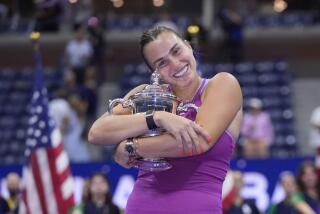U.S. Open Includes All the Elements
- Share via
NEW YORK — For tennis fans, it doesn’t get any better than this: controversy, crowds, heat and sulking millionaires. That’s right, it’s time for the U.S. Open, that annual pockmark on a sport with an otherwise smooth complexion.
This is the tournament that everybody loves to hate. It is played in a city where hating is an art form, and in a facility within earshot of Mets’ fans loudly cursing their own team. This may be the only sporting event in the world that carries with it the exact personality of its city’s cab drivers.
The hate is not so much a negative as it is a badge of honor. To loosely paraphrase this city’s theme song, if you can win it here, you can win it anywhere. Those carrying off the big trophies in this tournament are as much survivors as winners.
The players all say the same thing: “If you can get through this one alive. . . .” But then, so do the fans, officials, ushers, hotdog-sellers, sportswriters and ballboys.
The fact that it is the fourth, and last, of the tennis Grand Slam events every year merely adds to the scene. It is the last chance to make a good year great, or a horrible year passable. If you want to be No. 1, this is probably where you will or you won’t.
The brash and the brazen, the Jimmy Connors’ and John McEnroe’s and Andre Agassi’s, become instant heroes here. Everywhere else on the tour, when they fling out the F-word, mothers grab their childrens’ ears. Here, they get a standing ovation and five fat guys take off their shirts and do the wave.
The controversy began early this year--a full five days before the tournament opens today. The U.S. Tennis Assn., apparently trying to cover all bases of people it might be able to anger, deviated from the ATP tour rankings in its men’s seedings list, and then didn’t place the seeded players in the draw until all others were on the board. That angered players who had not been seeded according to their ranking and players who did not believe that the seeded player they had drawn merely fell in the next bracket by the required coin flip.
So, the draw was done over, but the seeded list remained the same. And that led to the sulking of millionaires.
Saturday, Russian Yevgeny Kafelnikov, ranked No. 4 in the world and seeded No. 7 in the U.S. Open, packed up his wrist bands and went home, telling the New York Times: “I don’t want to be part of a tournament that does things like that.”
Sulking millionaire No. 2 is Thomas Muster of Austria, No. 2 in the world and No. 7 on the U.S. Open seedings list, who is said to be pondering a conversation with Kafelnikov’s travel agent.
Les Snyder, the tournament chairman, denied that the seedings were arranged to prejudice the draw. He told Associated Press that he ordered the men’s field redrawn because of “my respect for player opinions.”
U.S. Open officials, who have the right to deviate slightly from tour rankings but who have seldom done so, contend this year that they are placing more stock in a player’s history on hard courts. That works for Muster, most of whose feats are of clay, but not for Kafelnikov, who won this year’s French Open, but also is solid on hard courts.
So, the way things worked out, defending champion and top-seeded Pete Sampras, an American, is targeted to face his toughest test in the semifinals, that against No. 4 Goran Ivanisevic of Croatia, whom he recently beat in straight sets in the final of a tournament in Indianapolis. And No. 2-seeded Michael Chang, an American put there when Muster wasn’t, is targeted to face No. 6 Andre Agassi, an American, in the semifinals, especially if Muster goes home in a huff.
That would mean that the USTA has given itself its best opportunity possible for a Sampras-Chang final or, even better in the organizers’ minds, a Sampras-Agassi final.
And everybody thought all the USA flag-waving ended with the Olympics.
The women’s draw lacks the controversy, but not the intrigue. Last year’s final matched an ailing, psychologically frail Steffi Graf against returning superstar Monica Seles, and when Graf somehow prevailed, the tennis world anticipated a series of these toe-to-toe thrillers. But the two haven’t met since, and while Seles has the second-seeded spot below Graf, her ailing left shoulder, in drastic need of surgery at season’s end, may not carry her to another High Noon showdown here on Sept. 8.
The spoiler could be Newport Beach’s Lindsay Davenport, who won the Olympic gold medal by beating Spain’s Arantxa Sanchez Vicario and took out Graf in straight sets in the semifinals of the recent Manhattan Beach Acura Classic, a tournament she won. Davenport is seeded eighth.
U.S. Open Notes
Germany’s Boris Becker is still bothered by the wrist injury he suffered at Wimbledon and will not play. . . American Chanda Rubin also has a wrist injury that knocked her out of the Olympics and will keep her out of the U.S. Open. . . . Other likely seeded women out because of injuries are Mary Pierce of France and Meredith McGrath of the United States.
(BEGIN TEXT OF INFOBOX / INFOGRAPHIC)
U.S. Open at a Glance
* SITE: Flushing Meadow, N.Y.
* WHEN: Monday through Sept. 8
* SURFACE: Hard courts
* TV: Channel 2 and USA network
* DEFENDING CHAMPIONS: Pete Sampras and Steffi Graf
* PURSE: $13.1 million ($600,000 to men’s winner, $575,000 to women’s winner)
More to Read
Go beyond the scoreboard
Get the latest on L.A.'s teams in the daily Sports Report newsletter.
You may occasionally receive promotional content from the Los Angeles Times.











